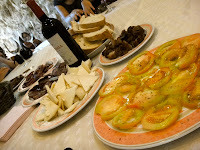 |
| the view from the castle-like farm house. |
Our driver was a bit of a nut case. Apparently he had two GPS systems, both of which he apparently refused to use. Our 8am departure was supposed to lead us to a 10:30am meeting but was more around noon.
Squinting into the sunny afternoon, we stood in a field that wafted sweet aromas of mint as we met with a producer of jamon iberico de bellota. This particular producer uses only a little salt as he likes a sweeter taste to the meat - the amount of salt used depends on the size of the leg - but it is also a bit risky for the drying process as salt is the only preservative used. The legs are then washed in cold water and hung in a central room of 10 degrees with 80% humidity. The drying room is oriented towards the sun to follow the natural cycle which coordinates with the natural temperatures to ensure quality control. Wind currents and light are the two most damaging things.
Jamon imberico refers to the breed of the pig, like serrano ham comes from the white pig, but the quality of the ham depends on the feeding:
1. jamon iberico de belloto is the highest grade and the free-range pig is fed a diet of only acorns found seasonally in the forests where they roam.
2. jamon iberico recebo means that the pigs were running around eating acrons in the field but didn't reach the desired or required weight so had to be re-fed with grain feed.
3. jamon iberico cebo extensivo and intensivo are both fed a diet of only grain and can be either free range or kept in stables.

the producer was able to recognize an iberico ham from the space between his fingers when wrapped around the smaller-than-usual calf as well as distinguish a bellota ham just by touch. The hoof is kept on the leg, unlike prosciutto di parma. The hoof, or nail, is typically black in the iberican pig breed and called pata negra, black foot. However, some ibericans don't have the black foot, but all pata negras are iberico. He explained that some people don't like the look of the foot attached to the ham - I can understand how the thick black hairs can be offputting - but I think that they probably shouldn't be eating the ham anyways - it is important to know where food comes from. right?
piggies running free in the forrest.
bellota means acorn in spanish.
acorn means squirrel in dutch.
we drove into the forrest as far as the bus could take us until we had to walk onto the dirt road that led us amongst the wild pigs running around in the mud and uphill to the farmer's house. we overlooked fanstastic views of the Andalusian countryside, the sun highlighting all of the country's vegetation and the swimming pool tempting us all to dive in to cool off. We had an appropriate meal based on pork: addictingly salty chicharrones - fried pork rinds, rather-unmemorable salami flecked with whole black pepper, lomo embuchado - a chewy dry cured pork, a local cheese, slices of tomatoes dressed in olive oil, and of course, jamon iberico de bellota that was carved table-side in front of us. It was sweet in flavour and the fat glistened in the dim light.
 |
| the producer |
 |
| jamon iberico |
 |
| Sung and Jules carving the leg. |
To finish the day's lessons, we ended at Eurocork, a company that produces corks for wine and bubblies.
If we weren't so tired and if the bus hadn't made us rush through what we could with the delay, it could have been a lot more interesting. Luckily, the guy was nice enough to stay at work a bit longer to give us a quick lecture about the production, while the rest of the employees went home. From mainly around Andalusia, Extremadura, and Portugal, the bark from the cork oak trees - divived into plots so that the bark can re-grow every nine years - is stripped manually with an ax and grinded. The boards of cork are cut into coin sized discs which are then glued together to create the bottle cork stoppers, but better wines will use corks that don't have glue so there is no risk of oxidation.
 |
| glued cork |
 |
| solid cork |
 |
| will be glued together. |
 |
| champagne cork. will expand into a mushroom. |
That night we had our only group dinner in Ronda - a feast at Sol and Sombra Restaurant. We arrived so late it was dark but I had heard how beautiful the city was. David from the Ronda Rural Development Department gave us a tour around the city pointing out important buildings, sites and historical anecdotes. It really was enchanting and filled with small town charm - old buildings illuminated by the yellow street lights, huge gorges alluding to dark crevices and daring only the brave to look below, and little alleys that intertwine the city like ribbons up and down the cobblestoned hills. It requires a return in the daylight.
Ronda at Night.







No comments:
Post a Comment